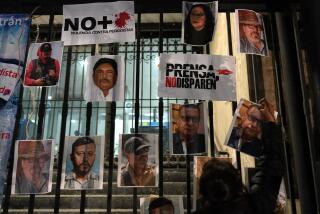Red-letter day for Salazar
The U.S. Postal Service will issue a stamp today honoring Los Angeles newsman Ruben Salazar, who, through his reporting and opinion columns during the 1960s, became a provocative voice for a Mexican American community searching for its political and social identity.
Among the first Mexican American reporters to work at a mainstream newspaper, Salazar was killed Aug. 29, 1970, struck in the head by a high-velocity tear gas projectile fired by a sheriff’s deputy during an anti-Vietnam War demonstration in East Los Angeles. He was 42.
A Times columnist and general manager of KMEX-TV at the time of his death, Salazar quickly became a cultural icon. Awards are granted in his memory, and roads, schools and parks have been named after him. His likeness appears on posters, murals and lithographs, including one by the famous Mexican painter David Alfaro Siqueiros. Folk songs were written about him.
He is one of five American journalists being honored with stamps. The others are Martha Gellhorn, John Hersey, George Polk and Eric Sevareid.
The work and death of the husky man with piercing eyes, wavy black hair and a penchant for Louis Roth suits continue to haunt and inspire people.
Among them are a restaurant owner who for half a century has been helping Latinos campaign for political office, a professor writing a book about injustices Mexican Americans have suffered at the hands of law enforcement, a woman trying to separate myths from facts about her famous father, and a continuation high school student trying hard to get back on track.
But after 38 years of reminiscing and interpretation, can the true personal, professional and political depths of Salazar’s life ever be known?
The truth, like everything else about Salazar, is complicated. Born in Juarez, Mexico, he was a political moderate who married a young white woman and lived in a middle-class home with a swimming pool in Orange County. Salazar was especially fond of dining on steak and corn with his wife, Sally, and their three children.
Yet, Charlie Ericksen, the founder of Hispanic Link, a Latino news service that publishes a weekly newsletter, recalled, “The husband that Sally knew was so different from the man we knew that it was almost as though he changed uniforms while driving down the freeway on the way home from work.
“Sally said he didn’t like tequila, he preferred Scotch, and that he didn’t like ‘that Mexican music,’ ” he said. “But the Ruben I knew often spent his last dollar on one more song by mariachis. He was mas mexicano than anybody.”
Ericksen, who was a staffer with the U.S. Civil Rights Commission in 1970, is among those who to this day believe that Salazar’s death inside the Silver Dollar bar was not accidental, as determined by the Los Angeles County coroner.
Just weeks before he was killed, Ericksen said, “Ruben called our office and said, ‘I just want to go on the record with you guys that the police are out to get me; I know they are following me.’ ”
About a year earlier, Salazar had left The Times, though he continued to contribute columns, to become news director for the Spanish-language station KMEX.
“We met up with him at a little place on Olvera Street that served great carnitas,” Ericksen said. “My boss kidded Ruben about the threats he was getting. ‘Ruben,’ he told him, ‘the community needs a martyr.’ ”
A week later, Salazar was dead. Raul Ruiz, a Chicano Studies professor at Cal State Northridge who was among the marchers in East Los Angeles the day Salazar was killed, has been investigating the incident for nearly four decades.
“I’m going to release my own conclusions about what happened in a book to be published later this year,” Ruiz said. “It’s called ‘Silver Dollar Death: The Murder of Ruben Salazar.’ ”
Lucy Casado will never forget the hot and humid evening when the telephone rang at her El Adobe Cafe, a modest Mexican restaurant famous for attracting power brokers and rock stars. On the line was a City Hall insider with bad news for her husband, Frank, now deceased, a political activist and close friend of Salazar’s.
“I started screaming out loud over and over, ‘They’ve killed him. They killed Ruben Salazar,’ ” Casado recalled. “Filled with grief and anger, my husband ran outside, grabbed a stick and scratched the words ‘Ruben Salazar: 8-9-1970’ deep into a square of wet cement on the sidewalk near the entrance.”
Standing over her husband’s markings recently, she shook her head and said, “They’ll stay there forever. It’s not a Hollywood star, but it is the emblem of a hero.”
But to Lisa Salazar Johnson, Salazar was simply “Dad.”
Seated at her kitchen table in Huntington Beach and sorting through a heap of letters, documents and photographs her father collected during assignments in the Dominican Republic, Mexico City, Vietnam and East Los Angeles, she said some of the accolades for the man who died when she was only 9 are puzzling.
“People assumed we spoke Spanish at home. We didn’t,” she said.
“And I’ll never forget how, when he was lying in an open casket, people kept walking up and laying rosary beads on his hands. A few seconds later, my mother would walk up and take the rosaries away. He wasn’t Catholic.”
Nonetheless, she said, “all this attention 40 years after his death is humbling, and there are still so many unanswered questions, starting with exactly how did he die.”
At Ruben Salazar High School in the working-class community of Pico Rivera, 12th-grader Janine Perez recently wrestled with a particularly tough assignment.
“When my teacher said we had to write an essay about Ruben Salazar, I wasn’t very excited,” said Janine, one of 250 students at the tiny continuation school surrounded by a 10-foot-high fence. “But after a week of reading about him in a booklet and on the Internet, I thought, ‘This man is really interesting. Maybe I can try and write something really good about him.’
“I spent a whole night just trying to understand his vision of the world, and what he did with his life,” she said. “Then I started writing. It wasn’t easy.”
The essay was still undergoing rewrites when Janine and her mother, Gabriela, were driving along Whittier Boulevard in search of a cake for her older sister’s baby shower. At one point, a row of storefronts caught the teenager’s eye.
“Oh my god! Mom, this is where it happened,” she blurted out. “There was a riot going on and a sheriff’s deputy shot him.”
“Who?” her mother asked.
“Ruben Salazar,” Janine said. “On Aug. 29, 1970.”
“Wow,” her mother said. “You’re really getting into this assignment.”
Janine, who wants to pursue film and video editing and acting, earned high marks for the essay.
“This assignment reminded me about how some grown-ups say Mexican Americans can’t get serious jobs,” she said. “But they don’t know me.”
--
More to Read
Sign up for Essential California
The most important California stories and recommendations in your inbox every morning.
You may occasionally receive promotional content from the Los Angeles Times.











